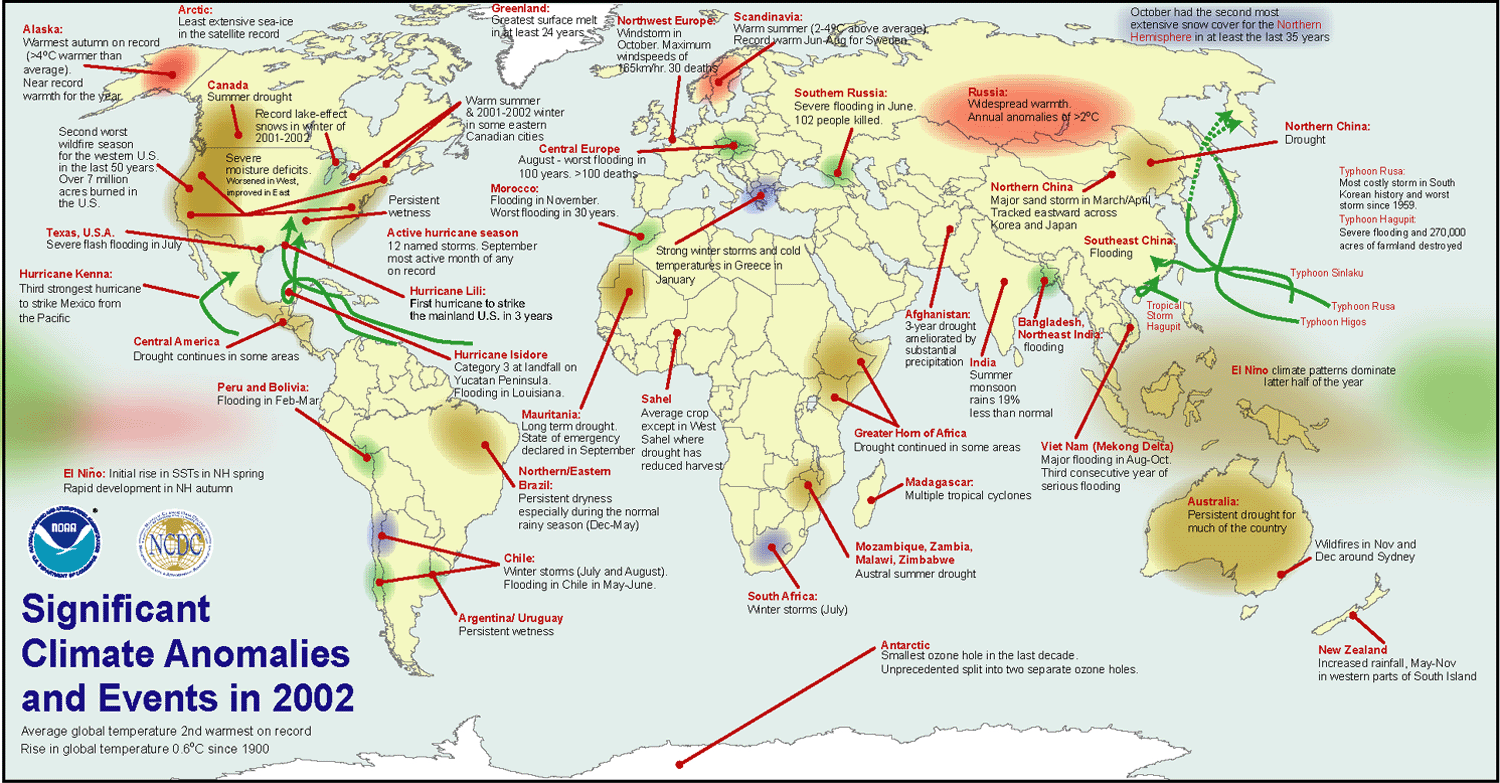
PLEASE NOTE: The ranks and temperature anomalies in this report represent the values known at the time the report was issued. The actual ranks will change as subsequent years are added to the dataset. The anomalies themselves may change slightly as missing or erroneous data is resolved. Also, in 2009, NCDC switched to ERSST version 3b (from version 2) as a component of its global surface temperature dataset. Because the versions have slightly different methodologies, the calculated temperature anomalies will differ slightly. For more information about this switch please see the Global Surface Temperature Anomalies FAQ .
Global Temperatures
| Global temperatures in 2002 were 0.56°C (1.01°F)* above the long-term (1880-2001) average**, which places 2002 as the second warmest year on record. The only warmer year was 1998 in which a strong El Niño contributed to higher global temperatures. Land temperatures were 0.87°C (1.57°F)* above average and ocean temperatures 0.42°C (0.76°F)* above the 1880-2001 mean. Both land and ocean temperature ranks as second warmest on record. |
 larger image |
|
The map of temperature anomalies (above right) contains data from an in-situ and satellite blended data set of land and ocean temperatures. The period of record for this data set is 1988 to the present, a relatively warm period compared to the base period used in the creation of the land only map of temperature anomalies. Some minor differences result from the differences in base periods and data that are used to construct the two maps. Neutral ENSO conditions at the beginning of 2002 gave way to a
strengthening El
Niño episode during late boreal summer and continuing
into early winter. Moderate positive anomalies of equatorial
Pacific sea surface temperatures (El Niño conditions) are
expected to persist through the early part of 2003. *Anomalies use most recent station data and NCEP OI Version
2. |
Global Precipitation
 larger image |
Global precipitation was below the 1961-1990 average in 2002. Much of Australia experienced severe drought, with the eastern part of the country the worst affected. India monsoon rainfall was 19 percent below normal, with the resulting drought characterized as the worst since 1987. Other drought-affected areas included the western United States and portions of the north coast of China. |
| After a dry beginning to 2002, several typhoons brought excessive rains to parts of southeast Asia and Japan, the southeast coast of China, Taiwan and the Philippines. In contrast to drought conditions during the first half of 2002, the onset of monsoon rains in southeast Asia promoted extensive flooding along the Mekong Delta. Seasonal flooding in much of south Asia (Nepal, Bangladesh and northeastern India) during June-August claimed more than 1,000 lives. In the eastern United States, long-term drought was ameliorated by a turn to wetter weather, due in part to moisture from tropical systems. |
Additional information on other notable weather events can be found in the Significant Events section of this report.
References
IPCC, 2001: Climate Change 2001: The Scientific Basis, Contribution of Working Group I to the Third Assessment Report of the Intergovernmental Panel of Climate Change. J.T. Houghton, Y. Ding, D.J. Griggs, M. Noguer, P.J. vander Linden, X.Dai, K. Maskell, and C.A. Johnson (Eds.), Cambridge University Press, 881 pp.

NOAA's National Climatic Data Center is the world's largest active archive of weather data. The preliminary temperature and precipitation rankings are available from the center by calling: 828-271-4800.
NOAA works closely with the academic and science communities on climate-related research projects to increase the understanding of El Niño and improve forecasting techniques. NOAA's Climate Prediction Center monitors, analyzes and predicts climate events ranging from weeks to seasons for the nation. NOAA also operates the network of data buoys and satellites that provide vital information about the ocean waters, and initiates research projects to improve future climate forecasts.
 NOAA's National Centers for Environmental Information
NOAA's National Centers for Environmental Information